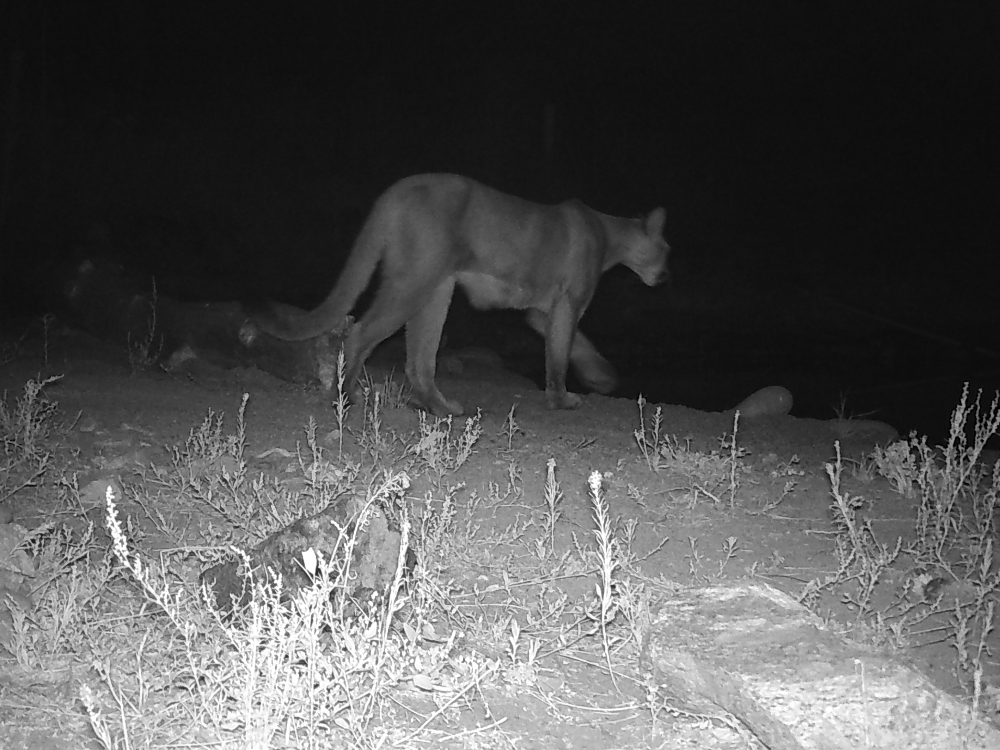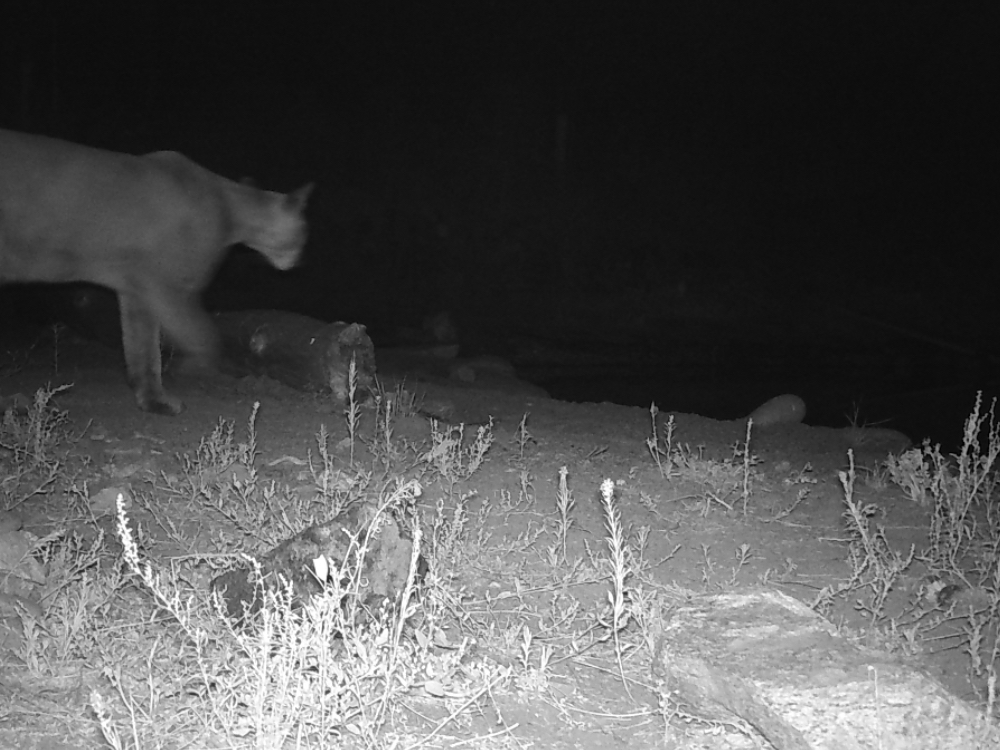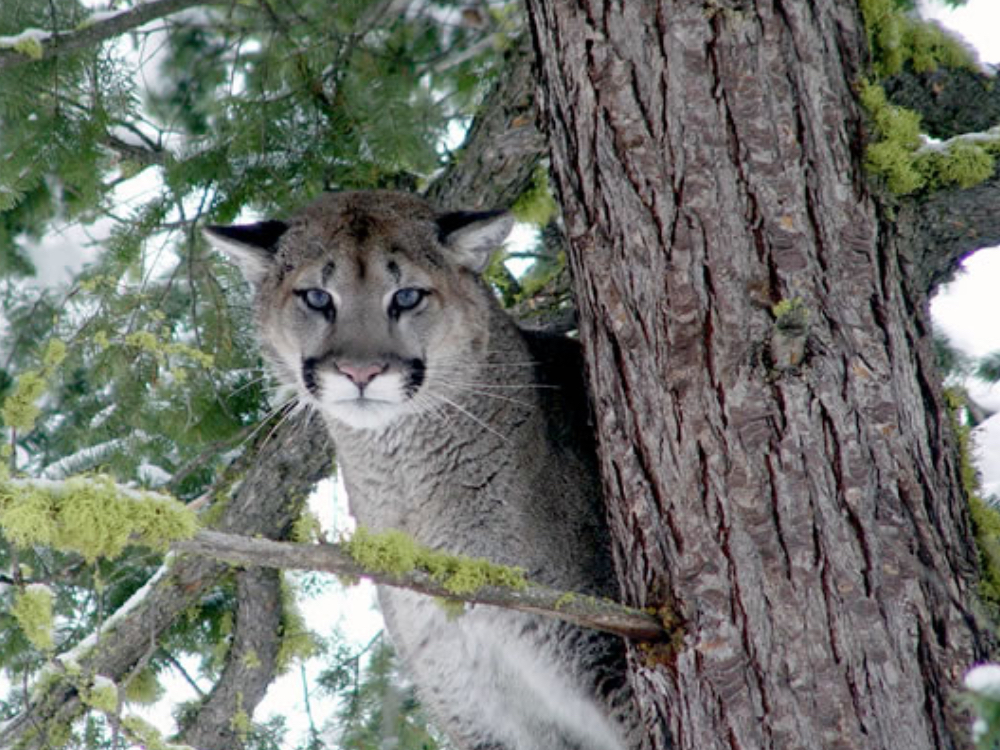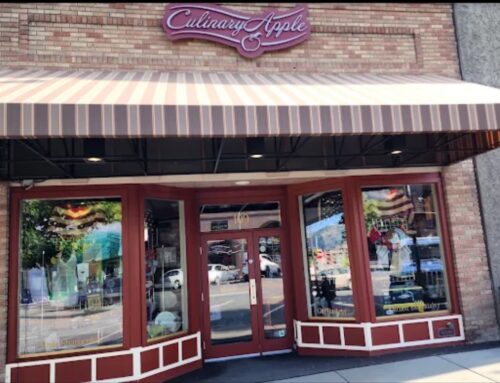Are Cougars a Threat?
by Loni Rahm
Our house sits in the wildlife interface at the base of Chelan Butte. Over the past 25 years we’ve seen the occasional cougar moving across the uninhabited territory above us – although it’s usually just a flash of movement seen only with binoculars.
Years ago, when our daughters — and the equally “hike-happy, let’s make forts in the ravine” neighbor girls — were young, we conscientious parents gave them preventative cougar encounter tips which include:
- Don’t run – cats love to chase
- Bunch up together and get big (expand your jackets or backpacks for example) so you look more like danger than prey
- And this was easy since the kids were rarely quiet – make noise as you hike and play. Cougars prefer to avoid you.
This summer we’ve gotten several reports of cougar sightings and photos from motion-initiated security cameras (pictured below from the Little Butte area). I was curious if the human-cougar interaction was increasing or moving closer to town. Time to call the expert.


Richard Beausoleil, with the Department of Fish & Wildlife, has been researching and monitoring regional bear and cougar movement for over 16 years in 7 study areas. Lake Chelan Now previously interviewed him about bear-sightings this spring when he shared with us the “Big 3” bear attractants to your back yard: 1) garbage; 2) bird-feeders; and fruit trees. Story link: bare facts about bears in the valley.
Turns out, there’s a “Big 3” for cougars as well.
As Beausoleil put it, “chickens are to cougars what garbage is to bears”. Hobby farms and free-range chickens will lure a cat out of the hills faster than anything. Well, almost anything. According to Beausoleil, cougars actually prefer goats and sheep, but chickens are more readily available.
“Remove the attractant and you remove the predator,” said Beausoleil. It’s a risk vs. reward equation. Large livestock like cows and horses are not worth the risk, he stated. Smaller livestock should always be brought inside at night when predators are more active.
Beausoleil indicated there is plenty of food in the wild to sustain these animals. But “putting unprotected goats, sheep, chickens etc. out there is like ringing the dinner bell. They may walk past the pen 20 times because they are in border patrol mode. Once hunger hits, they will seek the most convenient meal,” he said. “It’s a fast food drive up.”
I asked if there had been an increase in cougar growth and activity, and Beausoleil stated that the actual density of cougars per square mile is pretty consistent. An adult cougar has a territory of up to 150 square miles. The cougar spends 99% of his time doing “border patrol” along the perimeter and will defend these identifiable boundaries “vigorously” against cougar challengers.
Regional fires have undoubtedly impacted pieces of previously established territories, shrinking some turf and possibly displacing sub-adults — the 2-4 year olds who are old enough to leave mom but not mature enough to find and protect a new territory. As these young cats wander in search of their own perimeter, they must battle mature cats, and find food as they travel dozens of miles per day.
Beausoleil indicated that the cougar sightings reported over a one week period near Pat & Mikes, the one photographed on the Little Butte, and the one that darted across the road at Lakeside could easily have been the same one. “We’ve tracked cougars that move 50 or more miles in a day,” he said.
The bottom line: how safe are our pets, our livestock and our kids? As safe as we make them.
Dogs are curious by nature and will follow their nose when they smell something interesting. Beausoleil said he has seen “a Chihuahua with an attitude tree a cougar”. But dogs can also be agitators if a predator has a kill they are protecting, so the best rule when walking your dog at night is to keep it on a leash and quickly pick it up so it’s part of “your pack” if you encounter a predator.
Ditto with kids. Pick them up and make them part of your bulk. (the leash would be optional in this case).
Small livestock should always be safely housed at night. Put your chickens in the coop, and sheep and goats in a barn. Consider motion lights or motion-activated sounders or even wind-chimes — cougars spook easily and will avoid noise and lights. Don’t plant deer attractants or inadvertently feed deer with unpicked fruit or garden spoils either – since deer are also a “meal moving through the predator landscape”.
Cougars instinctively avoid humans. We instinctively avoid them. Mutual respect.
Feature photo credit: Richard Beausoleil, Department of Fish & Wildlife .
Read more about living with wildlife








